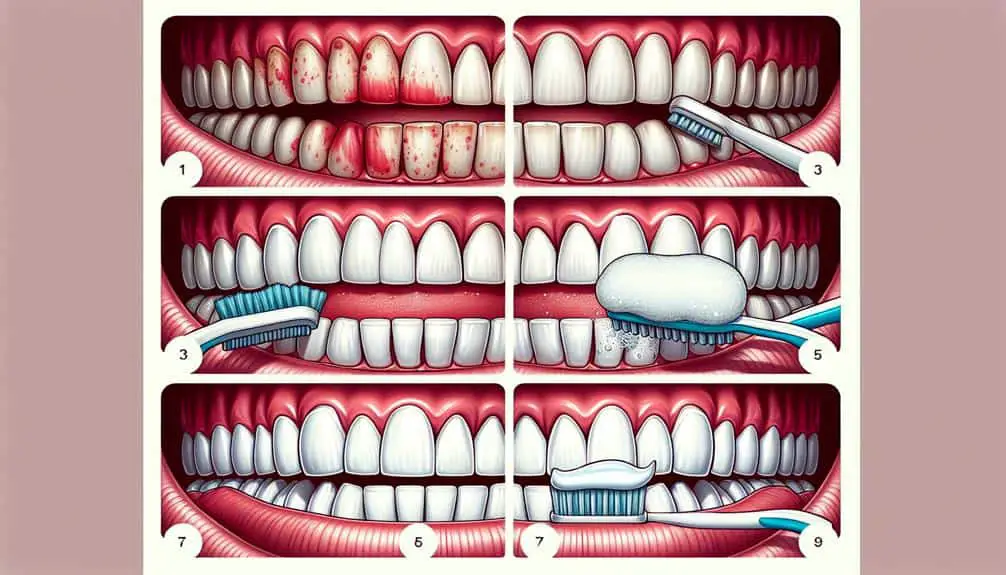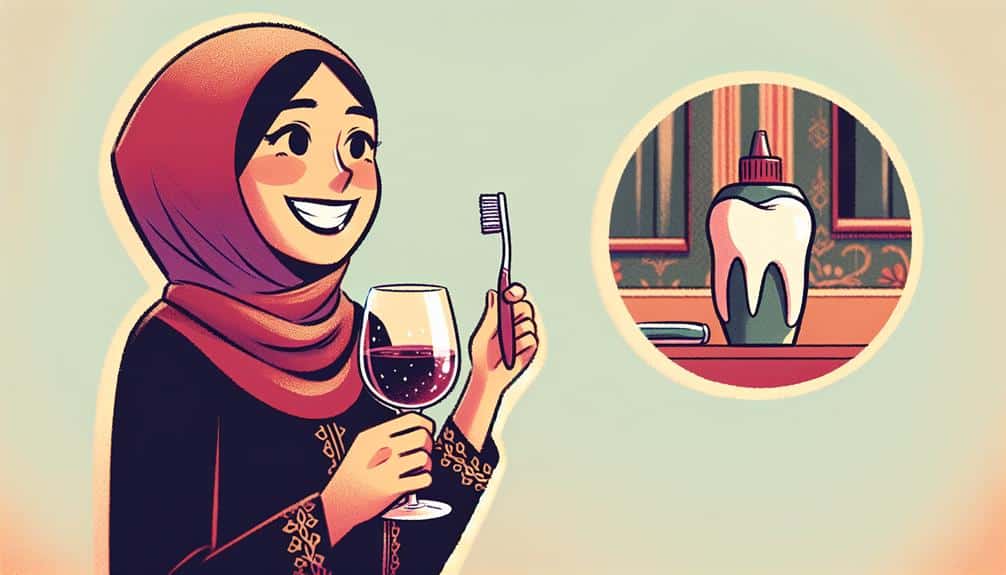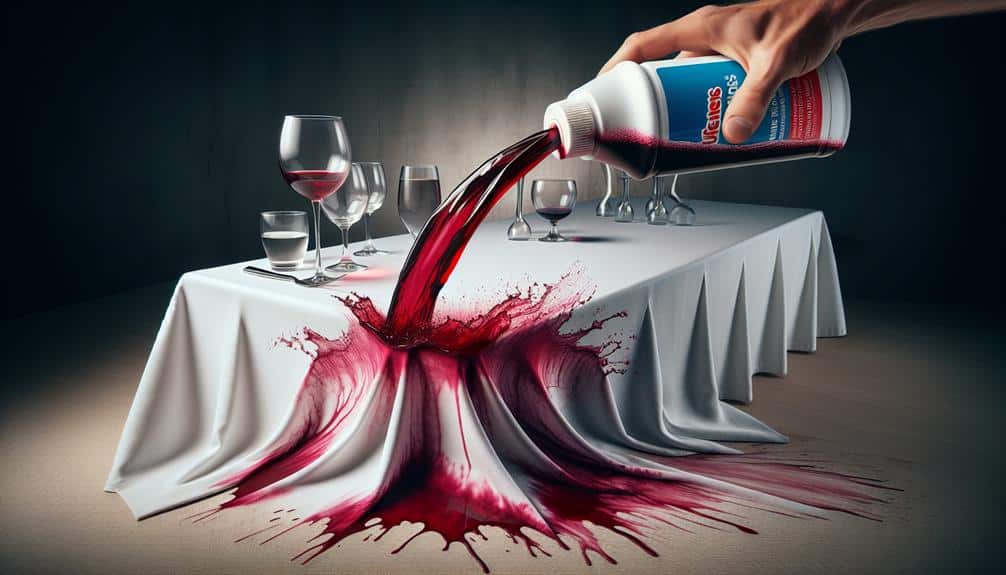To remove wine stains on your teeth, use a soft-bristled toothbrush with gentle circular motions. Lift pigments off the teeth with enamel-protecting toothpaste. Consider whitening toothpaste with hydrogen peroxide or carbamide peroxide. Safely explore DIY remedies like baking soda or hydrogen peroxide but consult your dentist first. For professional results, visit cosmetic dentistry experts for personalized whitening treatments. Maintain a stain-free smile by practicing daily oral hygiene, avoiding staining foods, and attending regular dental check-ups. Enhance your smile by following these effective tips.
Key Points
- Use gentle scrubbing motions with a soft-bristled toothbrush.
- Focus on small, circular motions to lift wine pigments off teeth.
- Choose enamel-protecting toothpaste for stain removal.
- Consider professional whitening options for noticeable results.
- Prevent future wine stains by maintaining good oral hygiene.
Brushing Techniques for Wine Stains
To effectively remove wine stains on your teeth, consider adjusting your brushing techniques for better results. When dealing with wine stains, it's important to use gentle scrubbing motions to avoid damaging your enamel. Opt for a soft-bristled toothbrush to make sure that you aren't too harsh on your teeth while still effectively removing the stains.
Focus on using small, circular motions when brushing the stained areas. This technique helps to lift the pigments from the wine off the surface of your teeth without causing unnecessary abrasion to your enamel. Remember, the goal is to be thorough yet gentle in your approach.
Additionally, be mindful of the toothpaste you use. Choose a toothpaste that provides enamel protection to safeguard your teeth during the stain removal process. By incorporating these gentle brushing techniques and enamel-protecting toothpaste into your oral care routine, you can effectively combat wine stains on your teeth without compromising the health of your enamel.
Whitening Toothpaste Recommendations
For best results in combating wine stains on your teeth, consider incorporating whitening toothpaste recommendations into your oral care routine. When choosing a whitening toothpaste to tackle wine stains, look for options that contain gentle abrasives that can help remove surface stains effectively without damaging your enamel. Additionally, select toothpaste that includes ingredients like hydrogen peroxide or carbamide peroxide, known for their stain-fighting properties.
To enhance the effectiveness of whitening toothpaste, you may also consider using dental trays or bleaching strips. Dental trays can help deliver the whitening toothpaste evenly across your teeth, ensuring consistent results. Bleaching strips, on the other hand, offer a convenient way to apply whitening agents directly to the teeth, targeting specific areas where wine stains may be prominent.
Remember to follow the instructions provided with the whitening toothpaste, dental trays, or bleaching strips for safe and effective use. Consistent use of these products alongside proper brushing techniques can help you combat wine stains and maintain a brighter, stain-free smile.
DIY Whitening Remedies at Home
Consider exploring DIY whitening remedies at home to complement your oral care routine and address wine stains on your teeth effectively.
When looking for natural alternatives, ingredients like baking soda, hydrogen peroxide, and activated charcoal can be beneficial in whitening teeth. Baking soda, known for its mild abrasive properties, can help scrub away surface stains. Hydrogen peroxide, when used safely and in low concentrations, can act as a bleaching agent to lighten stains. Activated charcoal, despite its messy application, has gained popularity for its ability to bind to toxins and stains on the teeth.
These quick fixes can provide temporary whitening effects, but it's important to use them cautiously to prevent enamel damage. Remember, DIY remedies aren't a substitute for professional dental care, and consulting your dentist before trying any at-home whitening treatments is advisable to make sure they're safe for your teeth.
Professional Whitening Options
Discover professional whitening options available through your dentist to effectively eliminate stubborn wine stains on your teeth and achieve a brighter smile. In-office treatments provided by cosmetic dentistry experts offer advanced solutions for individuals seeking a quick and best way to whiten their teeth. These professional procedures involve the use of specialized whitening agents and advanced technology to target deep-set stains caused by red wine consumption.
Cosmetic dentistry professionals can customize the treatment to your specific needs, guaranteeing a personalized approach for best results. In-office whitening treatments typically produce noticeable changes in tooth color after just one session, making them an efficient choice for those looking to enhance their smile quickly. The expertise of a dental professional ensures that the whitening process is safe and effective, minimizing the risk of damage to your teeth and gums.
Preventing Future Wine Stains
To prevent future wine stains on your teeth, implement daily oral hygiene practices that include regular brushing and flossing. Proper oral care can help remove surface stains and prevent them from setting into your teeth. Additionally, consider making diet modifications and lifestyle changes to maintain a brighter smile.
Diet adjustments play a vital role in preventing wine stains. Limiting your intake of staining foods and beverages, such as red wine, coffee, and tea, can help reduce the likelihood of discoloration. Opt for lighter-colored foods and drinks like water, milk, or white wine to minimize staining effects on your teeth.
Furthermore, lifestyle changes can also contribute to preventing wine stains. Avoiding smoking and using tobacco products can help maintain the whiteness of your teeth. Regular dental check-ups and professional cleanings can also aid in preventing and removing stains effectively.
Frequently Asked Questions
Are There Any Specific Foods or Drinks That Can Help Prevent Wine Stains on Teeth?
When looking to fend off wine stains on your teeth, consider red wine alternatives like white wine or clear liquors. Additionally, incorporating tooth-friendly snacks such as crunchy fruits and vegetables can aid in prevention.
Can Using a Straw While Drinking Wine Help Reduce the Likelihood of Stains on Teeth?
Using a straw when drinking wine can help reduce teeth stains. Consider alternatives like reusable metal straws. Stay hydrated to minimize staining effects. Experiment with hydration techniques to find what works best for you.
How Long Does It Typically Take for Wine Stains to Set on Teeth After Consumption?
After consuming wine, stain prevention starts immediately. The timing of absorption can vary but generally, wine stains set on teeth within 30 minutes. Red wine tends to stain more. Proper brushing techniques can help minimize discoloration.
Are There Any Long-Term Effects on Teeth From Frequent Wine Consumption and Staining?
Regular wine consumption can lead to tooth enamel discoloration. It is crucial to uphold good dental health practices to prevent long-term effects. Did you know that 43% of wine drinkers have reported experiencing teeth staining from wine consumption?
Is It Possible to Completely Remove Deep-Set Wine Stains on Teeth With At-Home Remedies or Professional Whitening Treatments?
To completely remove deep-set wine stains on teeth, consider professional teeth whitening through cosmetic dentistry. At-home remedies may help, but for stubborn stains, professional treatments offer more effective and lasting results. Consult a dentist for personalized advice.



